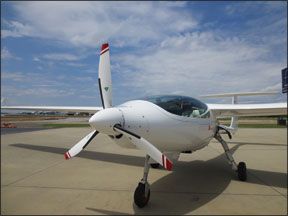Attempting to combine two genres in one aeronautical vehicle requires compromises that have historically generated less than stellar results. The mating of airplanes and cars has, for generations, given us offspring that were eminently forgettable performers as airplanes or cars. Flying boats have proven a little better—although, on the water, they are fragile beings requiring great care and, in the air, pay a penalty in fuel burn, speed and payload for shoving the weight and shape of a boat hull through the sky.

Yet, the arranged marriage, by Dr. Reiner Stemme (Stem-E), of closer relations, a glider and an airplane, has been notably successful. A few years ago, the S6 motorglider twins emerged, differing only in the ability of their landing gear to retract. We flew the S6RT (retractable, turbocharged) and found that it provides the pure joy of a high-performance glider while being a surprisingly efficient, two-place, traveling airplane.
Development
Dr. Reiner Stemme (doctorate in laser physics), an avid sailplane pilot, formed his eponymous company in Strausburg, Germany, to build a self-launching high-performance glider. The resulting S10, with its retractable propeller, proved successful. Its high-aspect ratio, 75-foot wingspan gave it a glide ratio of 50:1, putting it we’ll into the top end of the serious sailplane competition set. Users we spoke to described it as a self-launching glider for the pilot who wants to soar 80 percent of the time and fly an airplane 20 percent of the time.
Stemme’s more recent development, the S6 series, seems to us to be targeted at a pilot who wants to split the time between airplane and sailplane flying about 50-50. With a high-aspect ratio wing spanning 59.05 feet, it has a 36:1 glide ratio (30:1 for the fixed gear), nothing to be sneered at in the sailplane world. Its turbocharged Rotax 914 F2 develops 115 HP (100 HP, max continuous) and provides a 30,000-foot maximum operating altitude, with cruising speeds exceeding 150 knots once above 10,000 feet.
The only blemish on the recreational flying aspect of the S6RT is that no aerobatics, including spins, are approved.
Certification
The S6RT was originally certified under European Aviation Safety Agency (EASA) regs. It later received FAA certification under FAR 21.29. It is manufactured and flight tested in Germany, then crated and shipped to the U.S. distributor, Bell Aviation, in Columbia, South Carolina. The airframe is primarily carbon fiber composite, although the center of the fuselage, housing the engine and main gear, is composite over a steel-tube framework. The engine drives a full-feathering MT prop via a shaft that runs between the seats and a gearbox just aft of the prop—a modern version of the P-39 and P-63 fighters of WWII. No, there is no aft-CG problem with an engine that is not mounted on the nose.
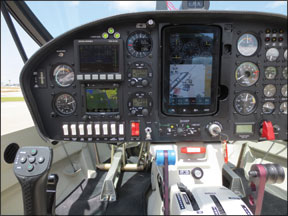
Flight controls are push-rod driven, except for a portion of the rudder system, which is cable-actuated. The two-segment ailerons are flaperons—they partially extend with the flaps, giving a full-flap stall speed of 42 knots. When turning, the outboard segment of each aileron deflects more than the inboard.
The manual flaps can be reflexed—deflected upward—8.5 degrees in cruise. There is also a neutral position, a takeoff/thermaling/landing 1 detent at 18.5 degrees and a landing 2 slot at 25 degrees.
Single-panel Schempp-Hirth style speedbrakes/spoilers extend from the top of the wing for descent control and to help pin the tires on the runway during rollout after landing.
Folding Wings
The wings can be folded for storage in a tee hangar. Unfortunately, the folding mechanism is clumsy and requires two or three people about an hour to fold or unfold the wings, something we feel should be remedied. The older Stemme S10 has a mechanism operable by one person in under 15 minutes.
The hydraulically actuated, retractable, tricycle gear tucks into the fuselage and is completely enclosed, giving the airframe a delightfully sleek look. The trailing beam main gear uses elastomer-damped springs with a six-inch travel to absorb landing loads.
The S6RT we flew was equipped with a Dynon 10A EFIS and an LXnav LX8000 color navigation and variometer system (sailplanes use a more sensitive vertical speed indicator, called a variometer or “vario”). The LX8000 includes AHRS, terrain and a sophisticated set of audio tones for rate of climb and sink as we’ll as aural warnings—it’s often referred to as a soaring computer. Most buyers also specify a Garmin 696 that will click in and out of a panel mounting arrangement. The aircraft we flew had a Garmin 796 so employed. Rounding out the panel were a Becker comm radio and transponder, each taking up only the space needed for a round dial instrument.
A popular option is a set of solar panels that help keep the battery charged when soaring with the engine shut down.
Price
The price is, frankly, staggering, and made worse currently by the strength of the Euro. Figure $340,000 for the basic S6RT—$363,000 equipped with high-end avionics. Knock off $15,000 if you buy the fixed-gear S6T. We were told this was the Ferrari of motorgliders—for performance, price and target market, it’s an apt analogy.
Bell Aviation in Columbia, South Carolina, has been the U.S. distributor for Stemme since 2007. Bell Aviation’s regular business is buying and selling bizjets and high-end turboprops. However, its proprietor, Don Bell, is a serious soaring and motorglider enthusiast and has owned more than one Stemme motorglider. When we met with him, Bell noted that Stemme has opened a distributorship in California.
Bell pointed out that buyers for the Stemmes he’s sold have opted for most of the options; he recalled only one going out with just the basics.
Options include a second fuel tank; the standard S6 comes with a 17.2-gallon tank in the right wing (0.5 gallon unusable). Another, holding 17.2 gallons (0.3 gallon unusable) is an option for the left wing. Ethanol-free premium fuel is preferred, with 100LL approved, but considered second best.
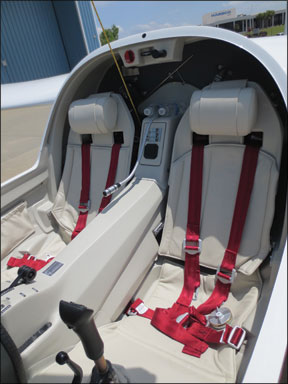
The empty weight of the S6RT we flew was 1599 pounds. Max ramp weight is 1984 pounds. With both standard and optional tanks full (201.6 pounds), the S6RT is a single-place machine—only 183.4 pounds may be carried in the fuselage.
The upside is that, with a fuel burn of only 5.4 GPH at 75 percent power, dropping to 3.9 GPH at 55 percent power, carrying reduced fuel still allows for reasonable range if going cross country—shutting the engine off altogether can expand the range considerably.
Published performance is impressive on 115 HP: takeoff over a 50-foot obstacle is only 1509 feet at sea level, with a published climb rate of 970 FPM. Book cruise at 75 percent power is 127 knots at 3000 feet and increases progressively with altitude as the turbocharger makes itself known—150 knots by 10,000 feet. Because the engine is expected to be shut down and restarted in flight, a maximum restart altitude is published—16,000 feet.
Combination of the Two Preflight is a combination of glider and two-place trainer—the only unorthodox parts include inspection of the flaperons to assure the various segments deploy appropriately at all flap settings and left/right stick positions and to install the nearly three-foot-long pitot tube. The length is dictated by the need to get the opening into undisturbed air. Since it is lightweight and fragile, it is removed between flights.
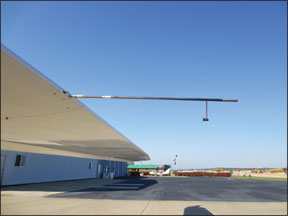
The canopy is hinged at the front and has three latches and a retention cord that is used to open and close it as we’ll as keep it from being yanked off the airplane when parked in a strong tailwind. The canopy can be jettisoned in flight should taking to a parachute be necessary. Boarding is standard sailplane, with the added challenge that the cockpit sill is more than three feet off the ground, making for some interesting gyrations.
The side-by-side seats are reclined steeply, and have adjustable backrests for different size pilots and to allow wearing a parachute. The rudder pedals adjust fore and aft. We found that an extensive range of heights and physiques could be comfortably accommodated.
Start up is Rotax simple—pretty much pull the choke and turn the key. The noise and vibration level is less than we’ve experienced in other aft-cabin-mounted engine airplanes such as the Skymaster. The steerable nosewheel makes for precise taxiing, something of importance as we were very aware of the long wingspan when maneuvering. The disc brakes are activated by a handle on the stick and worked smoothly.
Takeoff acceleration is rapid and smooth; the nosewheel is raised early, with the Stemme seeming to levitate at 50 knots. The deck angle is only slightly nose up. Once the gear and flaps are retracted the climb rate settled at just over 900 FPM. Vy is 68 knots. As full power is limited to five minutes, a reduction to 35 inches of manifold pressure and 2000 RPM is made within that time.
Prop RPM is maintained electrically; the control is a knob, making it easy to adjust, just different. All that’s required is to line the pointer on the knob up with the desired RPM on the placard around it.
Handling
The controls proved to be crisper than we expected from a sailplane. We’ve flown some that seemed to handle as if the stick were in a bowl of oatmeal—the S6RT was pleasantly responsive throughout its speed range. Steep turns proved easy to control, requiring less rudder than we expected for such a high-aspect ratio wing.
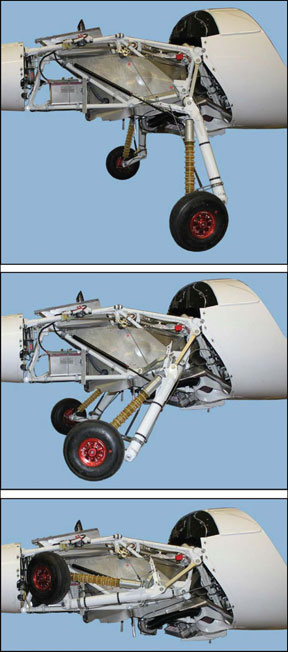
Stalls, both power off and dirty as we’ll as with the gear up, one notch of flaps and full power, had a noticeable, but not sharp, break. Attempting to hold the aircraft in the stall resulted in a pitch down and roll to the right, which could be stopped quickly with opposite rudder.
Setting up 75 percent power at 3000 feet generated 123 knots versus a 127-knot book speed. We experimented with cruise speeds with the flaps at the neutral setting and reflexed upward 8.5 degrees. We could not discern a measurable difference. With the flaps reflexed, the deck angle required to hold altitude caused the instrument panel to block the view directly forward, not a good state of affairs.
When it’s time to switch over to glider operations, a brief checklist is followed to reduce power, then shut down the engine and feather the prop. The noise level drops to nearly nothing, accompanied by the chirping of the vario as the hunt for thermals begins. Handling remained crisp, and we had no trouble quickly rolling into whatever turn was required to catch and then stay in a bubble of rising air. On a light-lift day, we easily maintained altitude, even when exploring the handling at different speeds.
Restart
Restarting the engine involves taking the prop out of feather, which took longer than we expected, perhaps a minute, then starting the engine, letting it warm to operating temperature and then adding power as desired. While the engine can bail out a pilot who gets too low away from an airport, getting the prop out of feather, the engine started and up to temp is something that should not be left until only a few hundred feet above the ground.
For landing, the pattern is flown at 20 inches of manifold pressure. The first notch of flaps can come out at 100 knots—as the speed drops below 75 knots, the gear is extended. It provides a most satisfactory thump as it locks into place. A check is made for “five greens,” the three gear lights, a green light that the prop is set for high RPM and a green indicating the aux fuel pump is on. Once below 75 knots, full flaps can be extended. Power is reduced to idle and the descent is controlled with the speed brakes. Even with full flaps, the Stemme seems to want to glide forever.
60 knots is held down final prior to flaring to a nose-high touchdown—we were cautioned to avoid touching down on the nosewheel. Once the mains touch, the speed brakes are fully deployed, which help to keep the ship firmly on the ground and give solid rolling control.
With the long wing, it’s necessary to assure that aileron is applied into any existing crosswind—it’s easy for the upwind wing to get lifted by a crosswind. Demonstrated crosswind speed is 16 knots, which we felt was about right.
Our overall impression was that other than a poor wing folding mechanism, the Stemme S6RT is an excellent machine for the pilot who wants to fly for the sheer fun of it and still wants to travel. Considering that no medical is needed to fly one and it’s more capable than an LSA, the S6RT may be what the doctor ordered.

